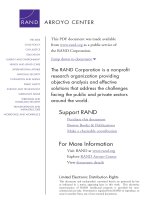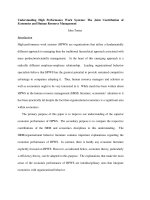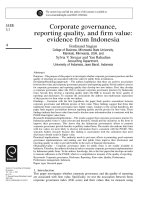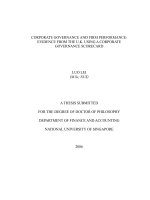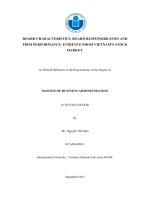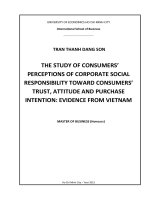Human resource management practices and firm outcomes, evidence from vietnam
Bạn đang xem bản rút gọn của tài liệu. Xem và tải ngay bản đầy đủ của tài liệu tại đây (169.96 KB, 45 trang )
Policies and Sustainable Economic
Development | 215
Human Resource Management Practices and
Firm Outcomes: Evidence from Vietnam
THANG DANG
University of Economics HCMC -
THAI TRI DUNG
University of Economics HCMC
VU THI PHUONG
University of Economics HCMC
TRAN DINH VINH
University of Economics HCMC
Abstract
Using a panel sample of manufacturing firms from small- and medium-sized
enterprise surveys between 2009 and 2013, we estimate the causal effects on
firm outcomes of human resource management practices at the firm level in
Vietnam. Employing a fixed-effects framework for the estimation, we find that on
average a firm that provides the training for new workers gains roughly 13.7%,
10%, and 14.9% higher in output value per worker, value added per worker and
gross profit per worker respectively than the counterpart. Moreover, an additional
ten-day training duration for new employees on average leads to 4.1% increase
in output value per worker, 3.0% rise in value added per worker and 3.0% growth
in gross profit per worker. We also uncover that a marginal 10% of HRM spending
results in about 2% and 1.6% rises in output value per worker and value added
per worker, respectively. Nevertheless, we find no statistically significant impacts
of incentive measure on firm outcomes. The estimated results are strongly robust
to various specifications.
Keywords: human resource management; firm outcomes; Vietnam
216 | Policies and Sustainable Economic Development
1. Introduction
Management-related functions inside firm significantly determine
firm’s growth (Bloom
& van Reenen, 2007; Milgrom & Roberts, 1990). Moreover, the theory
arguably treats “management as technology” and apparently indicates
the positive impact of management on firm performance (Bloom et al.,
2016). Among management-related functions, human resource
management (HRM) is probably the most fundamental part because it
fosters the efficient use of human resources (Bloom & van Reenen,
2011). Feasibly, examining the impacts on firm outcomes of HRM
practices is similar to that of the adoption of or the diffusion of a new
technology. Thus, that whether a firm carries out HRM practices
compared
to the counterpart is likely an understandable explanation for
1
dispersion in business results across firms.
The study of HRM is traditionally the realms of industrial sociology
and psychology which emphasize the functions of institutions and
culture as the primary determinants of the organizational structure
inside firm. Whereas conventional labor economics only focuses on
the study of labor markets such as labor demand, supply,
unemployment, and investments in education and this subfield of
2
economics
roughly
ignores
HRM-related
practices
inside
organization and leave them as “black-boxes.”
Recent decades have witnessed the development of economic
analysis of HRM within organization and the introduction of
personnel economics (Bloom & van Reenen, 2011). Personnel
economics examines two main problems facing any organization
including how to recruit appropriate candidates for available
vacancies, and how to organize work and motivate employees
(Lazear & Shaw, 2007; Lazear & Oyer, 2013). This study focuses on
the second issue and quantitatively explores the causal impacts of
HRM practices on firm outcomes using Vietnamese small and
medium-size enterprises (SMEs) data.
Many analogous studies are almost in developed countries such
the United States and European countries using econometric
analysis. However, there is a lack of studies from developing
countries including Vietnam. This study provides firm-level evidence
on the empirical literature of HRM practice impacts in Vietnam and
developing nations as well.
While HRM practices commonly consist of incentive/performance pay, profit-related pay, self-managed teams, performance feedback, job rotation, regular meetings and training, productivity is a common proxy for firm
outcomes in economics (Bloom & van Reenen, 2011).
1
2
HRM-related practices probably consist of paying structure, work organization and incentive mechanism.
Policies and Sustainable Economic Development | 217
Vietnam is a transition economy where there are the
transformations from many economic activities including business
functions inside organization toward modern international standards.
Firms’ applications and adoptions of contemporary people
management measures especially from the West become a
discernible trend in the context of growing globalization of Vietnam’s
economy (King-Kauanui et al., 2006; Truong & van der Heijden,
2009).
Small- and medium-sized enterprises are dominant and essential
subjects within the Vietnamese economy. SMEs amount to about
90% in 2000–2008, even 97% in 2008 of the total enterprises in
Vietnam (Vu et al., 2016). Moreover, SMEs play considerable roles for
the economy (Hung, 2007; Trung et al., 2009; Kokko & Sjöholm,
2005). For instance, SMEs account for approximately 40% of GDP
and 32% of the total investment in 2006 (Hung, 2007). In addition,
SMEs generate about 2.5 million of new jobs in 2005 (Trung et al.,
2009) and it was also the main driver for poverty reduction in rural
Vietnam (Kokko & Sjöholm, 2005). Given SMEs’ contributions,
understanding management-related practices including HRM actions
of SMEs therefore provides more efficiently evidence-based policies
for the pro-growth and the pro-poor strategies in Vietnam.
Research on the effect of HRM practices on firm outcomes for
SMEs is important for several reasons. First, evidence on the HRM
role in SMEs is a literature gap from the developing countries
because almost existing studies focus for the large-sized
organizations in developed countries (Ogunyomi & Bruning, 2016).
Second, SMEs account for a large share of total business and become
main drivers for economic growth especially in developing nations
(Cardon & Stevens, 2004). In addition, SMEs account for the
remarkable population of companies and become the significant
force for economic growth in the developing countries. Furthermore,
using various HRM practices likely produces various impacts on firm
outcomes (Bloom & van Reenen, 2011). In this study, we test
whether there are differences in the effects of some HRM practices
that include training (measured by binary and training days),
incentive measure, and per capita HRM spending.
Existing research on HRM is almost qualitative studies in Vietnam.
However, such studies are arduous to sufficiently reveal the importance
of HRM practices. Hence, quantifying the causal effect of HRM practices
on firm outcomes is more momentous for evidently discerning the role
of HRM practices. Providing quantitative evidence is this study’s main
motivation.
The paper is organized as follows. The next section provides a brief
literature review of the effects of HRM practices on firm results.
Section 3 presents identification strategy in which we specifically
discuss econometric specification for the estimations. Section 4
218 | Policies and Sustainable Economic Development
describes data source and the sample used in this study. Section 5
reports the main estimation results while section 6 provides further
robustness checks for the main estimates. Finally, section 7 makes
some conclusions.
2. Literature review
The existing literature detects that HRM practices have significant
effects on firm outcomes such as productivity, performance, or
innovation. Cooke (1994) provides evidence for the positive effects
of HRM practices on firm outcomes in Michigan, the United States. In
particular, the application of employee participation and group
incentives rise value added. Lazear (2000) finds that there is an
increase of 22% in productivity stemming from a change in the
payment method from flat hourly wage to per windshield piece rate
pay for American firms.
Black & Lynch (2001) find that the labor productivity for American
non-manager employees is remarkably and positively associated
with the profit sharing strategy – an incentive measure, and the
correlation is even stronger for those from union enterprises. Bartel
et al. (2007) reveal that HRM practices including team-working,
incentive pay and training result in increases in new IT technology
applications into the manufacturing activities in the United States.
Lavy (2009) discovers a strong and positive association between
teacher performance and bonus award based on pupils’ examination
pass rates and scores. Bloom et al. (2012) show that the people
management score (including multiple strategies such as over
careful hiring, performance pay, merit-based promotion, fixing/firing)
as a proxy for the HRM measure accounts for higher IT productivity
in Europe. Messersmith & Guthrie (2010) show that the use of high
performance work system is positively related to sales growth,
product and innovation for infant high-tech companies in the United
States.
However, the result of positive or negative impacts of HRM
practices admittedly depends on the proxy choices for firm outcomes
and even the data used. For instance, Freeman & Kleiner (2005)
discover that the termination of piece rates reduces productivity but
engenders a positive impact on firm profit. In addition, while studies
using cross-sectional data robustly are suggestive of positive
impacts on firm productivity of HRM practices, studies using timeseries data likely yield opposite findings (Ichniowski et al., 1997).
For research on the HRM role for SMEs from developing countries,
Ogunyomi & Bruning (2016) find that on average a firm using HRM
practices respectively have 12% and 16% of financial and non-financial
performances larger than those from the counterpart in Nigeria.
Policies and Sustainable Economic
Development | 219
King-Kauanui et al. (2006) is the first study on the effects of HRM
practices on firm performance in Vietnam and find that training,
performance appraisal systems and incentive pay are positively
linked to firm performance. Notably, incentive pay generates the
highest impact. Although this study focuses on SMEs, it only has a
small sample of firms in Ha Noi at one year. In contrast, we use a
large sample of firms in ten provinces of Vietnam in many years.
Given a sample allows us to investigate the impacts of HRM
practices on firm outcomes more comprehensive.
3. Identification strategy
In estimating the causal effects of a HRM practice on firm
outcome, researchers face a potential problem that the possible
existence of some determinants which simultaneously affect both
HRM practices and firm outcomes. In other words, there potentially
exists an endogeneity problem that highly produces bias estimates
using ordinary least squares (OLS) estimation procedure. For
instance, a firm that has good businesses is also more likely to spend
sufficient resources for its HRM practices. Therefore, it is important
to control for unobservable or omitted factors such as latent firmlevel characteristics that might jointly determine both HRM practices
and firm consequences.
In a standard manner, researchers commonly use an instrumental
variable (IV) approach to address this challenge. Notwithstanding,
identifying a satisfactory IV that fulfils requirements including: (i)
having an exclusion restriction, (iii) being uncorrelated with other
omitted variables, and (iii) having an ample strength is probably a
challenging task. Given this difficulty, we arguably employ a fixedeffects framework to control for latent factors and estimate the
causal impacts of HRM practices on firm outcomes.
Moreover, using a panel sample of manufacturing firms from
Vietnamese SMEs between 2009–2013 enables us to apply fixedeffects model for the estimation. Also, we can regard 2009–2013 as a
short time so that we possibly treat undiscovered characteristics at
firm-level as time-invariant factors. It is therefore another rationale
for our usage of fixed-effects model as an identification strategy in
this study.
In the full econometric model, we specifically add dummy variables
for province and year and province-year interactive terms to restrain
determinants that probably change at these various levels over years
between 2009 and 2013. The regression equation is as follows:
=+++++++
where is a measure of an outcome for a firm , in a province and a
year . There are three key proxies for employed in this study
including (i) output value per worker, (ii)
220 | Policies and Sustainable Economic Development
3
value added per worker, and (iii) gross profit per worker. The
components , , and respectively correspond to firm, province, year
and province by year fixed effects indications; and is an idiosyncratic
error term.
is a vector of control variables for firm and province
characteristics in the main specification. In particular, control
variables for firm characteristics include firm size, ownership
structure, whether firm has informal status, whether the firm is
exporting firm, and whether firm is inspected; and a control for
4
province characteristics is the competitive provincial index (PCI) . In
the section of robustness checks, we add more control variables for
manager characteristics including education, whether manager’s
main income source is only from the firm, whether manager is a
veteran, and whether manager is a party member. Importantly, we
add control variables in the model to resolve a potential threat to our
identification, namely other factors that are correlated with HRM
practices supposedly associated with firm outcomes.
Next, denotes a HRM practice that is employed by a firm , in a
province and at a year . HRM practice variables include a wide range
of HRM activities that were implemented by a firm over the last year.
In particular, the HRM practices are (i) whether the firm provided the
training for its new employees, (ii) the days of training, (iii) whether
the firm employs incentive measure consisting of additional
payments and fringe benefits as a main method for managing
employees, and (iv) per capita HRM spending.
The parameter of interest is the coefficient , which presents the
reliable causal effect of a HRM practice on an outcome of the firm
under the assumption of strict exogeneity conditioned on the fixed
effects estimation. Standard errors are clustered at the province
level to conduct the statistical inference robust to heteroskedasticity
and serial correlation within provinces over time.
4. Data and the sample
The data source of this study is from SMEs surveys. SMEs surveys are
jointly carried out for every two years by University of Copenhagen,
General Statistics Office (GSO) of Vietnam, Vietnamese Institute of
Labor Science and Social Affairs (ILSSA), and Central Institute for
Economic Management (CIEM) of Vietnamese Ministry of Investment
and Planning. The first
Note that to handle some variables with negative or zero values, we implement log transformation using
the Stata commands.
3
4 PCI is constructed based aggregate information at the provincial level regarding different dimensions which include the market
entrance, land access, transparency, time cost, informal cost, dynamic environment, business assistance, labor training, and legal
institution (VNCI, 2008, 2010, 2012).
Policies and Sustainable Economic
Development | 221
wave of SMEs survey is in 2002. The aim of SMEs surveys is to elicit
various information of a firm including its general information,
history, household characteristics of the respondent that is the
manager or the owner of the firm, the characteristics of production
activities and technology used by the firm, the structure of sales,
indirect costs, raw materials and services, aspects related to
investments, assets, liabilities and credit, fees, taxes and informal
costs, employment, and environment.
The sample for each wave of survey includes about 2600 nonstate-owned manufacturing firms located in 10 Vietnamese
5
provinces including Ha Noi, Phu Tho, Ha Tay , Hai Phong, Nghe An,
Quang Nam, Khanh Hoa, Lam Dong, Ho Chi Minh City, and Long An.
For instances, the 2009 survey consists of 2659 firms while the
commensurate figures for the 2011 and 2013 surveys are 2552 and
2575 firms, respectively.
Although the data is generally structured as a cross-sectional
structure for each year, a subgroup of SME firms is repeatedly
interviewed from year to year. This advantage enables us to
construct a panel sample of manufacturing firms between 2009 and
2013 for this study. After cleaning the data sets and making the
checks for the consistent time-invariant characteristics among
available variables, we obtain a balanced panel sample of 4803 firms
during 2009–2013. We equivalently have 1601 firms for each year
and a firm on average has nearly 6 fulltime workers. The summary
statistics of the sample is specifically presented in Table 1.
Overall, the proportion of firms apply HRM practices as main
functional activities are modest. For training activities, only about
5.4% of firms from the whole sample provides the training for its
newly recruited laborers. For another measure of training, the
average number of training days that firms give its workers for each
training duration is only 1.13 days. Regarding the incentive
measures, approximately 20.1% of firms delivers additional
payments and fringe benefits to their workers as primary people
management strategies. Finally, the mean spending for HRM
activities per worker is roughly 1.03 million VND.
Admittedly, SMEs do not widely employ HRM practices as main
functions. This is probably due to most of firms among Vietnamese
SMEs is very-small-sized firms. In particular, micro firms account for
70.3% of the sample while the percentages of small and medium firms
are 23.7% and 6% respectively. The lack of resources for HRM practices
from micro and small firms highly likely leads to insufficient
investments in HRM activities. For instance, while only 1.7% of micro
firms provides training, the commensurate figures for small and
medium firms
Although Ha Tay province has been amalgamated into Ha Noi since 2008, SMEs surveys carried out after 2008 have classified firms in Ha Tay and Ha Noi in two
different provinces.
5
222 | Policies and Sustainable Economic Development
are 10.5% and 27.3% respectively. The mean training days are 0.3,
2.2, and 6.2 for micro, small, and medium firms respectively. Table
A1 in Appendices provides specific information on HRM practices
among firms.
Regarding firm results, average output value, value added and
gross profit generated by a worker are respectively nearly 151, 46,
and 27 million VND for the whole panel sample. Notably, for PCI
variable we collect data from the Provincial Competitiveness Index
(PCI) Project, Vietnam Chamber of Commerce and Industry (VCCI).
PCI is a proxy for the quality of business environment of Vietnamese
provinces. Other statistics on firm, manager and province
characteristics are in Table 1.
Policies and Sustainable Economic
Development | 223
Table 1
Summary statistics of the sample
Variables
Dependent variables
Total
Mean
Output value per worker
5.015
Value added per worker
3.819
Gross profit per worker
Independent variables
HRM practices
Training
Training days
Incentive system
HRM cost per worker
3.303
0.054
0.225
1.131
7.019
0.201
0.401
0.027
0.144
224 | Policies and Sustainable Economic Development
Variables
Total
Mean
Firm characteristics
Firm size
1.792
Household enterprise
0.677
Private/sole proprietorship
0.079
Partnership/collective/cooperative
0.027
Limited liability company
0.180
Joint stock company
0.037
Informal
0.336
Export
Inspection
Manager characteristics
0.062
0.214
Policies and Sustainable Economic
Development | 225
Variables
Total
Mean
Main income from firm
0.869
Veteran
0.071
Party member
0.093
Province characteristics
Provincial competitiveness index
(PCI)
Observations
55.317
4803
226 | Policies and Sustainable Economic Development
5. Empirical results
The effects of various HRM practices on firm outcomes are
reported in Tables 2–5. For each firm outcome as a dependent
variable, we present estimates from three different specifications.
Firstly, we estimate a parsimonious specification that only consists of
HRM practice variable and control variables (firm size, household
enterprise, private/sole proprietorship, limited liability company, joint
stock company, informal, export, inspection, and PCI) (model 1).
Secondly, we estimate an extended specification by adding year
fixed effects (model 2). Thirdly, we estimate a full specification that
include HRM practice variable, control variables, province fixed
effects, year fixed effects, and province by year fixed effects (model
3). Using three various specifications is one way that enables us to
test the robustness of the estimation results for each firm outcome.
In each model, we focus on the parameter of interest the coefficient
of HRM practice variable ( ) that indicate the true causal effect of a
HRM practice on firm outcomes under the fixed effects framework. We
use the estimation results from model 3 as the baseline estimates for
each dependent variable. The coefficients in column 3 for output value
per worker, column 6 for value added per worker and column 9 for
gross profit per worker from Tables 2–5 are the baseline estimates. The
following subsections present empirical results of the cause effects of
training, incentive measure and HRM spending on firm outcomes.
5.1. Training and firm outcomes
This study uses two measures for training including (i) training
dummy for whether a firm provides training for its new workers in
last year, and (ii) the number of training days. Tables 2–3 present the
estimation results for the causal impacts of training on firm
outcomes corresponding with a specific measure for training
activities among firms.
For the impact of whether a firm makes a training for its new worker,
the estimates from Table 2 overall indicates that firms with training
tend to have better outcomes compared to ones without training. For
output value per worker, the baseline coefficient is statistically
significant at 5% as shown in column 3. In economic sense, the
baseline estimate indicates that on average a firm with training leads to
a nearly 13.7% increase of output value per worker compared to a firm
without training. Columns 1 and 2 show statistically significant effects
of training on output value per worker at 1% and 5% when using the
first and second econometric models respectively. The corresponding
magnitudes of the effects are approximately 19.0% and 16.4%. It is
obvious that when province, year and province by year fixed effects
(model 1) are included in the model, the effect magnitude is smaller
that the
Policies and Sustainable Economic
Development | 227
commensurate figures for the model without any mentioned fixed
effects (model 1) and the model with only year fixed effects (model
2).
Meanwhile, column 6 indicates a positive impact of training on
value added per worker at a 10% level of statistical significance. This
baseline estimate indicates that providing the training for new
workers improves a firm’s value added per worker by about 10% in
comparison with the counterpart. Using other econometric
specifications, we also find statistically significant impacts of training
on value added per worker at 5% for model 1 in column 4 and 10%
for model 2 in column 5. The degrees of effects are 12.5% and 10.8%
for model 1 and model 2 respectively.
Notably, the baseline estimate for gross profit per worker loses its
statistical significance at conventional levels as presented in column
9 of Table 2. The only estimate using model 1 in column 7 is
statistically significant at 10% for gross profit per worker. This
estimate suggests that on average giving training to new workers
make a firm more profitability by a 14.9% rise of gross profit per
worker relative to a firm that does not have any training activities for
its new employees.
Apparently, the estimates from Table 2 as discussed above
generally demonstrate that training has positive and significant
impacts on a firm’s output value per worker, value added per worker
and gross profit per worker. Among three firm outcomes, training
generates the largest effect for output value per worker with a 13.7–
19% increase. Next, a firm’s gross profit per worker gains a 14.9%
rise by adopting training. Finally, training improves a firm’s value
added per worker by an additional amount of 10–12.5%.
228 | Policies and Sustainable Economic Development
Table 2
Training (yes/no) and firm outcomes
Independent variables
Output value per
Model 1
Training
0.
(0
Firm size
-0.
(0
Household enterprise
-0
(0
Private/sole proprietorship
0
(0
Limited liability company
0
(0
Joint stock company
0
(0
Informal
-0
(0
Export
0.
(0
Inspection
0.
(0
PCI
0.0
Policies and Sustainable Economic
Development | 229
Independent variables
Output value per
M
(
Constant
R2
Observations
Province fixed effects
Year fixed effects
Province by year fixed effects
Notes: * Significant at a 10% level, **Significant at a 5% level, ***Significant at a 1% level. Robust standard errors clustered on the
provincial level are in parentheses.
Partnership/collective/cooperative is omitted among firm’s ownership structure dummies.
4.
(
230 | Policies and Sustainable Economic Development
The causal effects of training on firm consequences are more apparent
for the measure of training days in Table 3. Accordingly, the estimates are
strongly statistically significant at 1% for all three specifications and all
three outcomes.
Columns 1, 2, and 3 of Table 3 show that one additional day for training
new employees gives increases in output value per worker. The estimates
from three specifications almost suggests the same magnitudes of the
effects. In particular, a more ten-day training leads to rises in output value
per worker by 4.1–5.1%. For the baseline result from column 3, a firm’s
spending one more ten-day training for new workers results in an 4.1%
increase in its output value per worker.
In the same pattern, the estimates in columns 4, 5 and 6 of Table 3
demonstrate that on average an additional ten-day time for training new
employees improves a firm’s value added per worker by 3.0–4.1%, in
which the marginal effect from the baseline model is 3.0%. Finally, the
estimates for gross profit per worker in column 7, 8 and 9 also show the
marginal effects of additional gross profit per worker stemming from an
increased ten-day training duration span between 3.0% and 5.1% in which
the baseline effect is a 3.0% increase in gross profit per worker. There are
obviously no considerable differences in the magnitudes among these
three firm consequences. Moreover, these findings show the strong
robustness of positive impacts of training day on firm outcomes.
Policies and Sustainable Economic
Development | 231
Table 3
Training days and firm outcomes
Independent variables
Model 1
Training days
0
Firm size
-0
Household enterprise
Private/sole proprietorship
Limited liability company
Joint stock company
Informal
Export
0
Inspection
PCI
0
Constant
4
